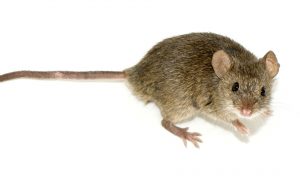
COMMERCIAL & DOMESTIC PEST CONTROL

The House Mouse and sometimes the Long-Tailed Field Mouse are found in buildings as they seek the warmth and shelter for nesting sites and food:
Appearance
The House Mouse body length ranges between 60-90mm and the tail can add an additional 100mm. They weigh less than 25g, and their fur colour varies between light brown and grey.
Characteristics
Mice have an acute sense of hearing, frequently using ultrasound to communicate, and are particularly sensitive to any sudden noise. Their presence is usually detected from their dark-coloured droppings or damage to stored foods in the larder, packaging or woodwork.
Habitat
Mice live in nests that they build out of cloth, wool and paper. Nests are often built inside houses, in places such as roof spaces, under floors or in wall cavities, and wherever there is access to a good source of food, especially during the winter. Mice can squeeze through cracks as small as 5mm but mouse holes are normally 20-30mm in diameter. Mice are mainly active at night and can often be heard running about as they search for food.
Diet
Mice are erratic, sporadic feeders, nibbling at many sources of food rather than taking repeated meals from any one item. They do not need free water to drink as they normally obtain sufficient moisture from their food. Their favourite foods are cereal products, although they will eat almost anything.
 Mice have been known to spread some nasty diseases to humans such as Salmonella, Listeria, which can cause food poisoning.
Mice have been known to spread some nasty diseases to humans such as Salmonella, Listeria, which can cause food poisoning.
 These nibbling nuisances have a compulsive need to gnaw in order to keep their incisor teeth worn down to a constant length. Electric cables, water and gas pipes, packaging and woodwork may all be seriously damaged by mice - many instances of electrical fires and floods have been attributed to them.
These nibbling nuisances have a compulsive need to gnaw in order to keep their incisor teeth worn down to a constant length. Electric cables, water and gas pipes, packaging and woodwork may all be seriously damaged by mice - many instances of electrical fires and floods have been attributed to them.
 Mice can ruin an organisation's reputation. If clients and customers spot evidence of rodent infestation in the premises you manage, they are unlikely to want to do business with you.
Mice can ruin an organisation's reputation. If clients and customers spot evidence of rodent infestation in the premises you manage, they are unlikely to want to do business with you.
 Property owners have a legal obligation under the Prevention of Damage by Pests Act 1949 to keep premises rodent free, or, if rodents pose a threat to health or property, to report infestations to the local authority.
Property owners have a legal obligation under the Prevention of Damage by Pests Act 1949 to keep premises rodent free, or, if rodents pose a threat to health or property, to report infestations to the local authority.
Signs of Mouse Activity
- Mice droppings - Droppings are often black, rod shaped and 3-6mm long. Fresh droppings will be soft and moist. Each mouse can leave approximately 80 droppings per day. Common places to find mouse droppings are under the kitchen sink, around central heating boilers and in roof spaces.
- Smear marks - These are dark grey marks left on surfaces by repeated contact with the oils in mouse fur.
- Nests - Sometimes nests can be found indoors for example in lofts, under floorboards or in airing cupboards.
- Gnawing - Mice gnaw continually on materials such as wood, carpets, paper, pipe cables and furniture. Check for damage to foodstuffs in cupboards.
How to prevent Mice
- Eliminate any harbourage points such as sealing gaps around pipes and under sheds; Mice only need a gap of 5mm to gain entry, but normally they are 20-30mm in diameter.
- Remove potential nesting sites by keeping yards and gardens clean and tidy, by cutting back overgrown areas and clearing any piles of wood/debris.
- Cover any household waste where mice can get access to it, close dustbin lids and cover compost heaps.
How to get rid of Rats:
It is important to get rid of mice quickly, as Mice are adaptable, highly mobile and breed rapidly - this combination can make mouse control a difficult task for the untrained individual.
